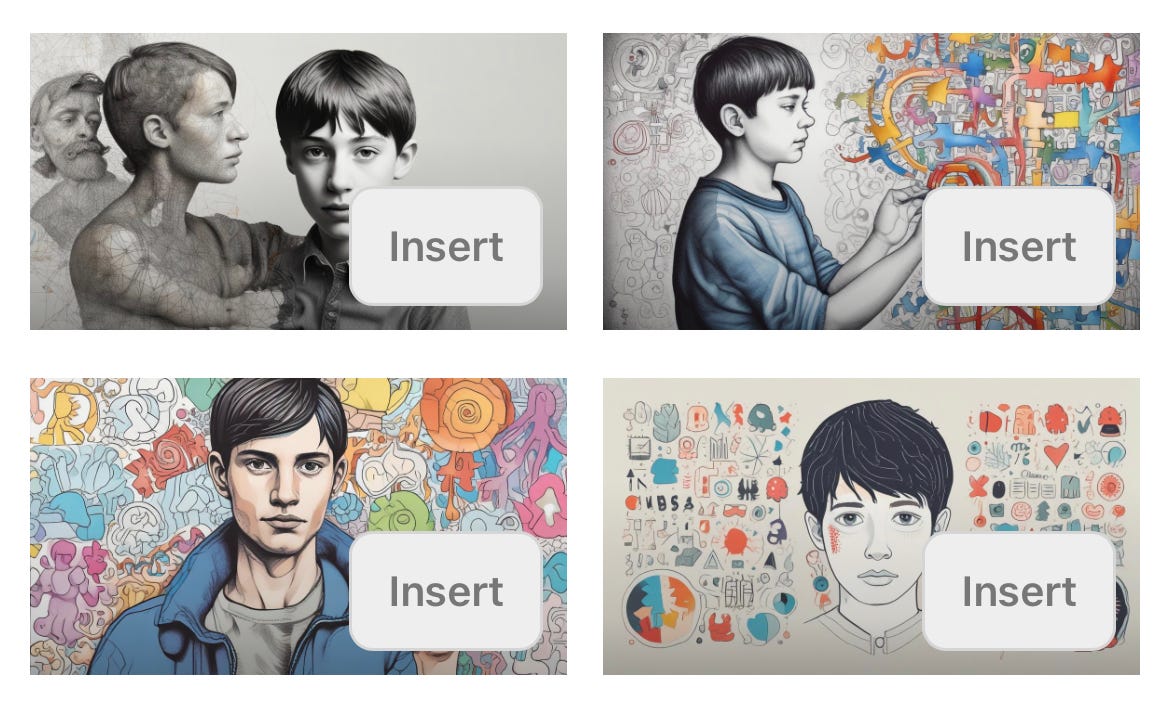Is "Female Autism" its own separate thing?
Not really... but there's a reason people try to specify.
Welcome to The Late Diagnosed Diaries, the bi-weekly-ish musings of a late-discovered autistic author and speaker, former journalist, and eternally curious human, featuring educational explanations, critical explorations, and vulnerable realizations, all seasoned with a teeny little dash of feminist rage.
If you spend any amount of time researching or reading about autism, you’re bound to run into the phrases “female autism” or the “female autism phenotype.”
And if you’re anything like me, you may find yourself wondering why there’s gender specification at all.
As far as science can tell us, autism is binary: there is no such thing as being “a little bit autistic” or “very autistic.” You’re either autistic or you’re not, and that fact remains consistent from the moment you’re born to the moment you die.
And diagnostically, “autism,” “male autism,” and “female autism” are not separate diagnoses. We’re all just “autistic.”1
But because autism research has historically centered on the experiences of cisgender men, and excluded the experiences of (or even denied the existence of) autistic women, when most people think of “autism,” they’re really only thinking of the stereotypical male experience of autism.

Labeling certain autistic experiences and traits as “female,” therefore, seems like a simple way to refer to the autistic experiences that aren’t reflected in the male-as-default definition and depictions of autistics.
But, personally, I’m not sure that “female” is the best word to do that.
Of course, some of the autistic traits and behaviors included in these lists reflect the unique stigmas, social pressures, and discrimination that female autistics face.
But the vast majority of differences aren’t genital… They’re behavioral.2
A 2022 study of undiagnosed autistic women began with this definition: “According to Female Phenotype Theory (FPT), autism in women may be missed by clinicians due to a combination of better-than-expected social functioning, reduced severity of externalising behaviours, and greater internalisation of emotional difficulties.”
All of those things are clear contributors to many female autistics going undiagnosed and reflect experiences that autistic women have.
But having “better-than-expected social functioning” isn’t something that only women can do, and female autistics aren’t the only ones with the ability (or necessity) to mask external behaviors and internalize emotional difficulties to get by in life.
And if that’s true, then the male-centric stereotypical autism traits and diagnostic criteria don’t just exclude females, and these alternative trait lists likely don’t just refer to females.
This is bigger than sexist research practices.
Much bigger.
Beyond Gender
A 2022 meta-analysis3 of autism research noted the “continued failure of research or diagnostic manuals to appreciate the complexity or variation of autistic people,“ noting that the bias in research goes beyond sex and gender markers: “...white participants were included at over eight times the rate of Black participants, at ten times the rate of Asian participants, and roughly 7 times the rate of Hispanic/Latino autistic people.“
A 2021 article4 in the Journal of Developmental & Behavioral Pediatrics also observed that while there aren’t major differences in the prevalence of autism among different racial and ethnic groups, “White children and those of higher socioeconomic status are more likely to be both identified and diagnosed with ASD earlier compared with Black, Latinx, and Asian children, as well as children from low-income families.“
Many of the same societal forces that uphold patriarchy also offer a strong foundation to other systems of oppression, so I guess it shouldn’t come as a surprise that the autism research that has historically skewed toward men is also skewed toward those who are white and rich.
*sigh*
We also know that autistics are more likely to identify as gay, bisexual, and asexual than non-autistics, and more likely to be unemployed or underemployed than any other disabled group.
Each of these things—gender, race, socioeconomic status, sexuality, and employment status, as well as religion, cultural identity, and more—impacts an autistic’s experience of the world, the expectations society places on their behavior, the stigmas and discrimination they face, and their access to health care and accommodations.
When we position autistic traits, behaviors, and experiences that aren’t represented in the conventional understanding of autism as purely “female autism traits,” I fear we’re just using gender to create a second woefully incomplete, reductive, and exclusionary understanding of the autistic experience.
What if—instead of focusing on gender as the sole differentiator of the autistic experience— we focused on identifying behaviors and traits of autistics with a wide range of complex intersectional identities that exist outside the “straight, white, rich, male” default we’ve historically been presented with?
If not “female autism,” then what?
I know that my own autistic experience is colored by a variety of privileges, and I wouldn’t ever claim to speak on behalf of all autistic individuals.
I’m also under no illusion about my right to unilaterally determine what label is more appropriate than “female autism” when we’re talking about traits and behaviors that exist outside the conventional understanding and current diagnostic criteria.
But, I do have a deep love of words and a strong desire to use the most inclusive language possible in my own writing and conversation.
In that spirit, I’ve been thinking of more inclusive alternative labels I could use where appropriate, and I wanted to share my thinking in case it’s helpful for anyone who may be doing the same for themselves.
I determined that calling these traits “atypical” would reinforce the male-as-default mindset, and it plays into the problematic use of “normal/abnormal” to discuss neurodivergence.
No thanks.
“Minority” is often used to refer to the identities we’re talking about, but my literal autistic mind simply cannot accept using this term to refer to a group that includes all humans who identify as female, BIPOC, and LGBTQIA2S+, since that group would more likely represent a majority of humans.
Pass.
A close cousin contender could be “marginalized,” but I don’t like the disempowering undertone (again, we represent a majority of humans!) or the vagueness of the term. Marginalized how? Where? By who?
We can do better than that.
I considered “underrepresented,” but there’s an interesting conversation happening around how blame-avoidant this term is, vaguely implying that the problem is that some people are just not showing up to be counted, instead of being methodically, intentionally, and systemically excluded.
Victim-blaming? Ew.
My current front runner is “under-researched.”
Here’s why it feels right to me at the moment, based on my current understanding:
It doesn’t attribute the variance in autistic experiences solely to a gender binary
It’s inclusive of any autistic identities, behaviors, and psychosocial experiences that aren’t being given due attention, both currently identified and yet unnamed
It makes no value assertions, and no claims about normality or abnormality
It doesn’t quantify the group’s size or compare it to the size of another group
It clearly identifies the underlying problem—the lack of research—which helps appropriately assign responsibility for change to the researchers, not the subjects.
It’s likely not the perfect substitution, but for now, it feels slightly better.
Until some other term rises to the top, I’ll be focused on trying to recognize when “female” is the correct qualifier, and when “under-researched” may be more accurate.
Thanks for reading The Late Diagnosed Diaries. Here are some other ways to support this newsletter and its author:
Note: “Aspergers” was a separate diagnosis from “autism” until 2013, when it was acknowledged as simply a different experience of autism and not a separate diagnosis. More on that here.
In full transparency, I’m perhaps irrationally proud of this sentence.
“Autism research is in crisis”: A mixed method study of researcher’s constructions of autistic people and autism research | Frontiers in Psychology | Volume 13 - 2022
Racial, Ethnic, and Sociodemographic Disparities in Diagnosis of Children with Autism Spectrum Disorder | J Dev Behav Pediatr. | 2021 Oct-Nov




